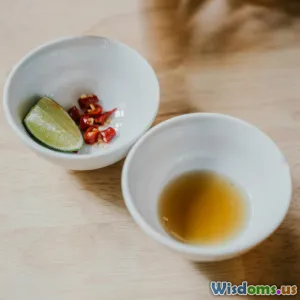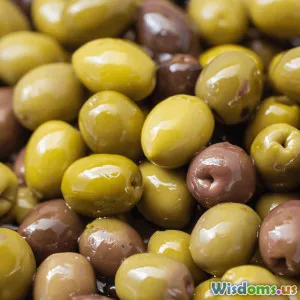
Unlocking Flavor Pairing Secrets
8 min read Explore the art of flavor pairing and elevate your culinary skills with unique insights and practical tips. (0 Reviews)
Unlocking Flavor Pairing Secrets: Enhance Your Culinary Experience
Cooking is much more than a necessity; it's an art form, a science, and an adventure in flavor. However, many home cooks struggle with knowing what flavors work well together—the key to creating extraordinary meals. Understanding flavor pairing can dramatically improve your dishes, leaving your guests and family impressed. In this article, we'll demystify flavor pairing and provide practical tips to help you unleash your culinary creativity.
The Science Behind Flavor Pairing
At its core, flavor pairing involves combining ingredients that complement each other, creating a balanced and harmonious dish. According to food scientists, like Harold McGee, the expert on kitchen science, flavors are made up of a combination of aromatic compounds. Certain compounds stimulate our taste buds in similar ways, leading to pleasing combinations.
Aromatic Compounds: The Building Blocks of Flavor
Take, for instance, the combination of strawberries and balsamic vinegar. When these two ingredients come together, it's not just about the acidity of vinegar balancing the sweetness of the strawberries. The flavor pairing is rooted in their organic compounds, meaning that their individual profiles positively affect each other’s flavors, resulting in a delightful combination.
Example: The Tomato and Basil Pairing
A classic example is the pairing of tomato and basil. The fruity acidity of tomatoes complements the herbal notes of basil, both influenced by their unique fragrant compounds that enhance each other's properties. By acknowledging the aromatic spectrum of ingredients, cooks can craft better-tasting dishes.
Common Flavor Pairings You May Not Know
While some flavor pairings are well-known, such as chocolate and peanut butter or beef and red wine, others remain undiscovered treasures. Exploring intriguing pairings broadens your culinary horizons. Here are a few worth trying:
1. Apples and Cheese
The tartness of apples paired with the rich creaminess of cheese creates a well-balanced bite. This classic French combination is often served on cheese boards, illustrated excellently by the pairing of sharp Cheddar with crisp Granny Smith apples.
2. Cilantro and Lime
This duo is fundamental in many Latin cuisines. Cilantro offers brightness while lime provides a zesty kick, perfect for marinades, dressings, and salsas. The warm undertones of cilantro's aromatic compounds seem to enhance the tartness of lime—truly a match made in culinary heaven.
3. Chocolate and Chili
Chocolate doesn't merely pair with sweet ingredients. The spice of chili adds depth and a surprising dimension to dark chocolate desserts or mole sauces. Several Mexican dishes leverage this combination, demonstrating the rich interplay between heat and sweetness.
4. Pear and Gorgonzola
The delicacy of ripe pears juxtaposed with the sharpness of Gorgonzola cheese is a classic yet sophisticated flavor pairing. This harmony of sweet and bold rich flavors can elevate a simple salad to a gourmet dish quickly.
Tools to Aid Your Flavor Pairing Journey
As with anything, understanding your bases can streamline the process of flavor pairing in the kitchen. Luckily, technology and culinary resources have provided chefs with excellent tools.
Flavor Pairing Apps
Several mobile applications, like Foodpairing or FlavorWiki, offer extensive databases of ingredients and suggest ideal pairings based on shared flavor compounds. Users can input a primary ingredient and receive suggestions, significantly simplifying the cooking process for innovative recipes.
Infographics and Charts
Visual aids can enhance understanding. Charts from sources like The Flavor Bible by Karen Page and Andrew Dornenburg illustrate how certain ingredients blend harmoniously, creating a successful roadmap through otherwise convoluted flavor files.
Elevating Your Dishes With Umami
One must consider the fifth taste—umami—in exploring flavor pairing. Coined by Japanese chemist Kikunae Ikeda, umami is characterized by its savory profile and complements many ingredients, including tomatoes, mushrooms, and aged cheeses. Adding umami-rich ingredients can enhance depth and complexity.
Utilizing Umami in Pairings
For example, when constructing a noodle salad, adding soy sauce (umami) will compress the flavors and make the ingredient selection more unified. Consider combining fresh ingredients like cucumber and radish with cooked mushrooms—umami works to tie flavors brilliantly.
The Role of Texture in Flavor Pairing
It isn’t just flavor on its own that matters—texture plays a significant role as well. Crunchy and soft elements can create an enjoyable dish. Have you ever enjoyed the combination of soft goat cheese atop a crisped crostini? The complementary textures enhance the overall dining experience, highlighting the flavors even further.
Emphasizing Texture in Pairs
A dish of sautéed spinach topped with crunchy toasted almonds illustrates how different textures can enhance flavor pairing. You’re not just enjoying the taste; you experience the crunch and soft taste together—this duality keeps each bite engaging.
Experimentation: The Key to Mastery
Even with guidance from science and resources, true expertise comes from experimentation. Successful flavor pairings often stem from trying things out—the essence of culinary liberty.
Practice Makes Perfect
When preparing a meal, try pairing ingredients on the fly: include a new herb or add a splash of wine where you traditionally wouldn’t. Discover the beauty in culinary mistakes. A failed dish could lead to more tantalizing options in future creations.
Case Study: Fusion Cuisine
Take a cue from fusion cuisine trends. Consider the sushi taco punctuated with spicy tuna (Japanese) and served in a taco shell (Mexican holder)—mashing the pair changes everything you knew about both world cuisines, again showcasing culinary creativity without bounds.
Conclusion: Unlocking Your Culinary Potential
In conclusion, flavor pairing is an exciting journey that can significantly enhance your culinary creations. From understanding the chemistry of flavors to experimenting with textures and unconventional pairings, there’s always something new to discover. Whether you’re an avid home cook or a seasoned chef, unlocking the secrets of flavor pairing can transform mundane meals into memorable feasts. The key lies in continuing to explore, innovate, and—most importantly—taste!
Let your imagination and taste buds lead the way.
Rate the Post
User Reviews
Popular Posts





















